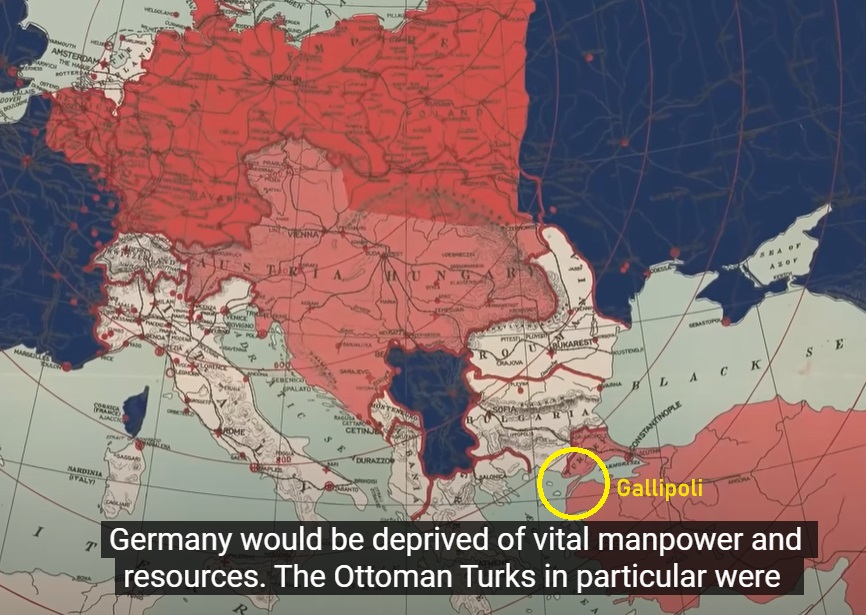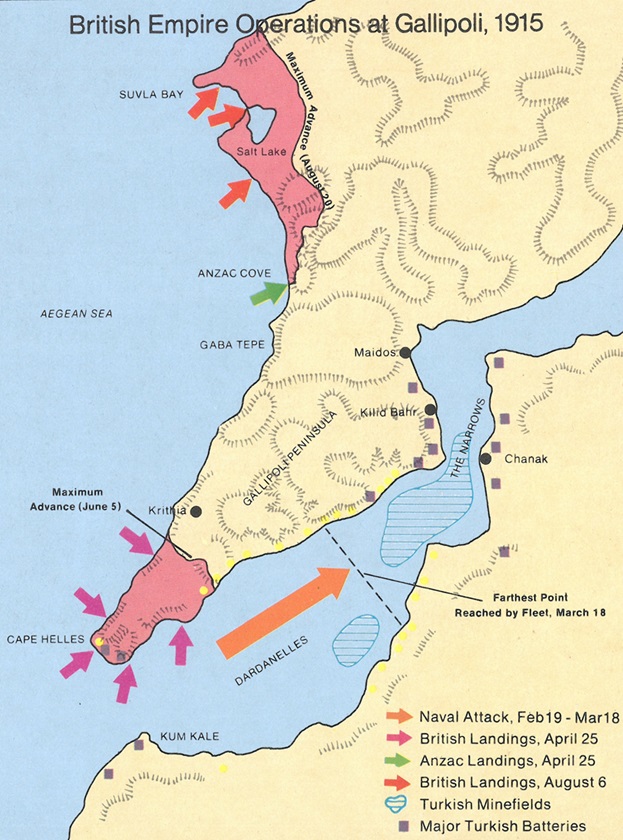|
       
Search for a Solution - A Second Front
Reasons for the Campaign,
The Gallipoli Campaign, Why the Campaign Failed, , Consequences,
You will often see the Gallipoli campaign as part of a ‘The War Elsewhere’ page, but I am including it here because, actually, it was part of the push in 1915 to find an alternative to simply slogging it out on the
Western Front.
 This Imperial War Museum video
gives an excellent account of the campaign (recommended). This Imperial War Museum video
gives an excellent account of the campaign (recommended).
|
|

Stalemate on the Western Front It was hoped that a breakthrough in Turkey would open a back
door to attack Germany, and draw German resources away from the Western
Front.
Churchill Winston Churchill, First Lord of the Admiralty, pressed very hard for a ‘second front’.
Russia was losing badly to the Germans on the Eastern Front … and was running short of ammunition and supplies because Germany’s ally Turkey had closed the Dardanelles to Allied shipping.
Capturing the Straits from the Mediterranean into the Black Sea would
allow the Allies to supply Russia.
Ottoman empire The Ottoman Empire/ Turkey was ‘the weak man of Europe’ in terminal decline. It had
been driven out of the Balkans in 1912 and the British had easily defeated it in [what we now call Iraq] in 1914.
The British expected an easy win which would take out Germany’s ally.
Threaten Austria-Hungary In the Balkans, Serbia had defeated the Austro-Hungarian army in August 1914, and it was suggested that a successful attack through the Balkans might subsequently take Austria-Hungary out of the war.
|
Going Deeper
The following links will help you widen your knowledge:
Contemporary footage
 Voices of
WWI: Gallipoli (plus transcript) - IWM Voices of
WWI: Gallipoli (plus transcript) - IWM
New
Zealand soldiers' experience
YouTube
Soldier's letter

Soldier's
diary
Soldier's memories

|
|
March 1915
An Anglo-French naval attempt to sail into the Straits to attack Constantinople failed.
Two French and two British ships were hit by
artillery fire or mines and sank, and HMS Inflexible (one of the only
two modern ships the British had sent) hit a mine and was severely
damaged.
25 April 1915
The Mediterranean Expeditionary Force landed on the Gallipoli peninsula
It included soldiers from Australia and New Zealand
(the ANZACs) and a unit from India, as well as British Territorials and
a French division.
The plan was to clear the Turks out of the peninsula and allow the navy through to attack Constantinople
The ANZACs landed at Gaba Tepe, the British and French, under Sir Ian Hamilton, landed on beaches on Cape Helles.
They suffered heavy casualties just landing and barely established a
bridgehead.
July 1915
Six new divisions were sent to Gallipoli. Hamilton tried a third landing at Sulva Bay, but that too failed to make any progress.
December 1915
By October, Gallipoli was beginning to look as expensive and as stalemated as the Western Front, and the
invasion and defeat of Serbia in October-November wrecked any hope of a campaign against Austria-Hungary. Hamilton
was replaced by Sir Charles Monroe, who advised evacuation, which took place in December.
Casualties
The Allies suffered 115,000 casualties.
A 1906 investigation had advised that the Straits were heavily mined and defended by fixed fortifications and advised against an assault; it was ignored. Minesweepers were sent with the fleet in March, but were actually trawlers manned by civilians with little experience of how
to clear mines. Operating within range of the Turkish artillery, they soon had to withdraw. The Turks had well-hidden mobile artillery which was difficult for the Navy’s ships to knock out. -
The failed March attack alerted the Turks, who had time to prepare their defences.
The British underestimated the Turks, who were
motivated and were led by experienced commanders, including German
officers and the Turkish nationalist Mustafa Kemel … who simply copied
German defensive tactics from the Western Front (i.e. they transferred
the stalemate of the Western Front to Gallipoli). By contrast, because Gallipoli was playing second fiddle to the Western Front, the Allies
had sent inexperienced troops and commanders. Gallipoli was a long way away and regarded as less important – the Allied forces faced supply problems. In particular the Force lacked heavy artillery. Poor on-the-ground reconnaissance/intelligence meant that the Sulva assault failed when the attackers became lost during the night attack. Conditions were dreadful, including unaccustomed heat
and lack of water, and lack of space to bury waste or the dead. This caused dysentery, and the
Force struggled to hold their position, never mind advance. In October Bulgaria joined the war, giving
Germany a direct rail link to Constantinople and the chance to supply
the Turks, resulting in the invasion and defeat of Serbia by the end
of November.
|

A map of the Gallipoli peninsula and campaign,
Consider:
"Modern histories are tending to focus on how to integrate the bottom-up records of soldiers’ experiences with the top-down records of
plans and dispositions."
1. If you were telling the story of Gallipoli,
at what point in the narrative would you integrate the memories of the
men in the 'Going Deeper' section into the account of the campaign in
the text?
2. How would it affect your telling of the
story?
|
|
It was the end of talk of a second front, and proved the need for a deadly war of attrition. By encouraging Bulgaria to join Germany and Turkey, it
led to the defeat of Serbia, and failed to support Russia. It was a humiliating defeat for Britain. Churchill was dismissed and the Liberal government
collapsed, to be replaced by a much more war-focussed coalition
government.
It dinted Australian and New Zealand confidence
in Britain, and was part of the beginning of the end of the British
Empire. In Turkey, the campaign created national pride and cemented Kemel’s reputation … which would lead eventually to the establishment of the Turkish Republic with Kemel as its first leader.
|
Consider:
1. Rank the reasons the Gallipoli Campaign failed.
2. Why were the casualties so great at
Gallipoli?
3. Did the Allies gain ANYTHING from the
failure at Gallipoli?
- AQA-style Questions
1. Click to see the question.
3.
Write an account of how the Gallopoli campaign failed to break the stalemate.
4. 'The turning point of the war.' How far do you agree
with this statement about the Gallopoli ccampaign?
|
|
|
Spotted an error on this page? Broken link? Anything missing?
Let me know.
|
    
|
 This Imperial War Museum video
This Imperial War Museum video
